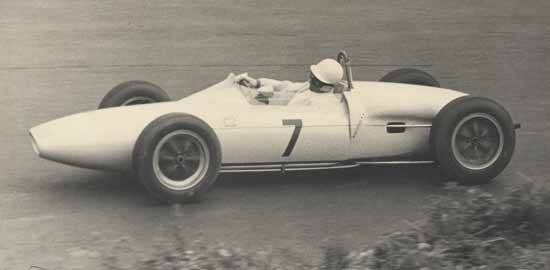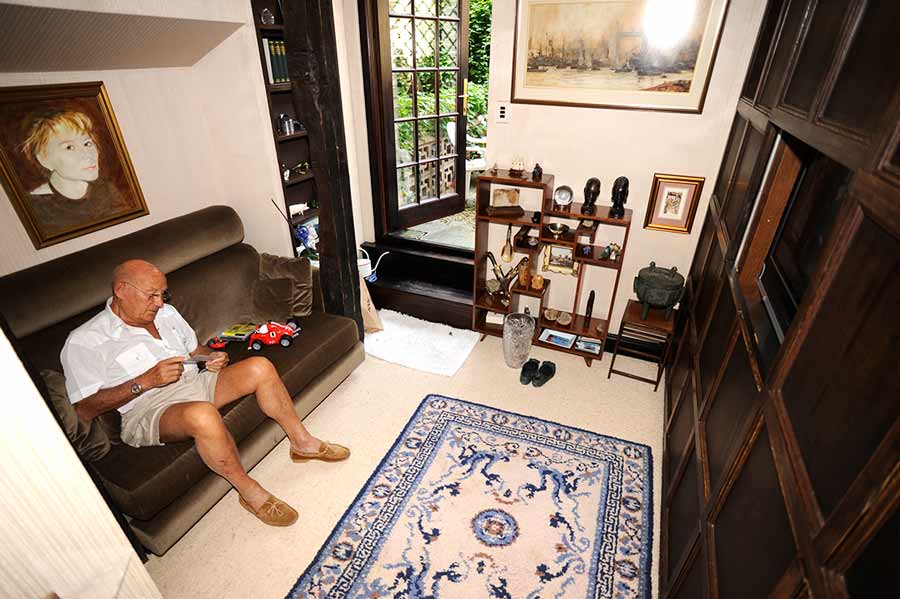
The Art of Driving - Stirling Moss in conversation with Philip Porter

PP: “Driving fast obviously consists of many factors, including reading the road, braking, setting-up the car, steering, balancing on the throttle, getting the power down, different lines, experimenting.”
SM: “A lot of that is gained purely by experience. When I first drove, I knew nothing at all about how cars handled. Then I did quite a lot of work with Alf [Francis, Chief Mechanic at HWM]. He said, ‘Well, let’s try these different shock absorbers'. So I got to know a lot about practical things: 'If you do this, that is likely to happen...'

“We also had a lot of testing to do on tyres and stuff like that which gave me quite a lot of mileage. The races were much longer, remember, three hours long or so. So my amount of racing mileage - I have never even tried to calculate it at all – but I must have done a enormous amount of racing miles, 100,000 or something like that in a racing car, in racing conditions. That is a lot of experience.
“You learn what cars will do. Cars have characteristics: understeer or oversteer, and in between. They all had their different foibles. Even two, so-called, identical cars were different.

“One's style of driving for the Mille Miglia is quite different to the style of driving for Monaco. Monaco: when you are going into a corner, you work out where your apex is and drive it accordingly. When you are on an open road, you can’t. You don’t know where the apex is - the Mille particularly because you have got a lot of people lining the sides of the road and, even if you could see the apex, they obscure it. So therefore you have to drive in a different style, so you go in as near ten tenths as you can and if something is wrong you then apply extra steering and back off sharply so you then put on full opposite lock just to drop the speed. Drop the speed as soon as you can by any manoeuvre. That is quite a different style.
“I think hillclimbs are the best place to start because the only person you are driving against is yourself, you are testing your own natural ability. When you have gone up and you try something, it shows you fairly graphically - yes that worked or it didn’t. In racing, of course, you keep going into a corner and you try one line then you may try a slightly different entrance and so on until you find the best one…

“The way to tell how quickly you are coming into a corner is to take a reading on your rev. counter as you leave the corner, rather than any other way, I find. At Goodwood, for instance, as I leave the double right-hander after the start, I want to be getting 4600 or whatever it is. You try yourself out and against other people. When there are other people there and they brake you know, really and truly, that if you can’t brake later than them then, you need to do something else!
“I think it took me many years to learn how to brake really late. It’s a very difficult manoeuvre and very destabilising to the car.”

“The point is [what] you have got to try and do is get onto the brake as late as you can and bring the throttle in as early as you can. Getting on the throttle earlier is more important than braking later, yes, but you have got to try and get the two together. The earlier you can get onto the throttle the better, providing you are not taking corrective action, because that slows you down a lot. People don’t realise that once you start correcting, it is knocking the speed off very quickly.
“A four-wheel-drift really should be classified as having the wheels all in the same line. If the front wheels are turned at all, it has actually got correction on; it isn’t therefore a proper four-wheel-drift.”
PP: “Is what you call a proper four-wheel-drift the quickest way through a corner?”
SM: “I reckon it is. Providing you are starting on the outside of the track, touching the apex and going to the outside, and not just doing that, but having to do that.
“I reckon you want to use all the road you possibly can but a lot of people don’t.”

PP: “And have it pointing straight as you exit the bend?”
SM: “Oh yes. If you have to use correction to do that, then obviously you have slowed yourself down. You would probably be quicker the next lap to go a little bit slower and hold it in there.”
PP: “Would you describe motor racing as a team sport or not? Obviously, you can’t do without the mechanics and the support of the designers and that sort of thing but when you were out there you were pretty much on your own.”
SM: “It is only a team sport when you are running two drivers with a car, which, of course, I have done and I enjoy. I wouldn’t really call it a team sport. You are very much on your own, aren’t you?”

PP: “And that appeals to you? You wouldn’t want to be in a team sport?”
SM: “Yes, I would say that. I can blame myself; I can beat myself harder; I can force myself to do things. There are things that I have done or made myself do which would not be realistic or right for me to try and do to somebody else; it would be quite wrong. It is a personal thing.”
PP: “Did you take risks?”
SM: “Calculated risks, yes. The thing is, it is really quite hard work being in a car and driving flat out. I pushed myself as hard as I possibly could. I remember once at the Nürburgring, I had done 40 laps out of 44, or something, and I was absolutely wrecked for at least a week. In the Alpine, I remember I drove terribly hard in one particular section because I had to and got into the control in time; the upside is so worthwhile that I wouldn’t mind doing it. Being on one’s own, you are where the buck stops; you can make all the decisions and that is what I like. I don’t think it is right that you should be able to push really dangerous things onto other people. To risk my neck is one thing but I don’t think it is right if I risk yours as well.”

PP: “How important was winning? Would you have risked your neck?”
SM: “Bloody important, yes. I suppose it is a surfeit of ego or pride, really. It gave me a tremendous amount. Certainly being faster than the other people in the team; that is what mattered.”

PP: “Would you frighten yourself sometimes?”
SM: “I wouldn’t normally frighten myself. There are times when I would be frightened by what happened. The most fear that I had in racing was before the [starting] flag fell. Once the flag falls, then I am not worried about it. I was really worried about the Mille Miglia because I didn’t know the circuit. Once the flag went down, I had got a job to do and that was it, that takes over. If you go round a corner and it was a bit too quick and you damn nearly buy it, that is when you know the risk you have taken.”
PP: “Would you always have a little margin?”
SM: “I always used to endeavour to leave myself a small margin, yes I did. I think poor old Stuart Lewis-Evans, probably didn’t. He was very fast, really fast. I always tried to drive within my capabilities, yes.”
PP: “Were there drivers who worried you because you felt they were about to have an accident?”
SM: “There were drivers that you would know to keep well away from, chaps like Willy Mairesse. You wouldn’t go too close.”
PP: “They were taking chances or wild?”
SM: “Wild. If a guy was really good, then it was a completely different situation. You could follow him closely, like I followed Fangio in 1955. I had great confidence in his abilities.”
PP: “Why do you think you were better than other people?”
SM: “Determination, stamina. I think that I could understand the language of the car, because all cars will give you a warning of one thing or another, I reckon I could interpret that earlier and more effectively that many others might.”
PP: “You must have had supreme reactions.”
SM: “My reactions were very fast; I know because they were tested. People always say that reactions are what really matter and I did have fast reactions but fast reactions, I think, are things that make you a bit safer. What makes you even safer than fast reactions is doing the right thing. However quick you are, if you do the wrong thing, it is no bloody good. You use reactions to get you out of trouble, not get you into it. If they are misused, for example if you over-correct, then you are starting a fish tail.”

PP: “But that is skill and experience; you get used to that. Balance must have been fundamental?”
SM: “Yes.”
PP: “Holding a car, steering on the throttle.”
SM: “The point is that you have to learn that to steer a car you have got a steering wheel, but that isn’t the only way to steer it. A steering wheel, to my mind, is used to just start the car pointing in the right direction. It says, ‘I am going to go right, I am going to go left’. After that you use it to compensate. So, if you are going into a corner and you want more steering, you apply more power. It is a case of balancing that when you are going into a corner. It is a case of understanding the dynamics and the balance of the car. To my mind, that comes from the experience of driving.”
PP: “You have said that you were racing so often that it became almost second nature. You were driving more than probably anyone else.”
SM: “Exactly, it is very important. To brake really late in my mind is what makes [Lewis] Hamilton exciting. He is a very good braker and, if you brake late, it gives you an opportunity to pass people without having to out corner them. That is quite important because you can’t really effectively pass a semi-comparable driver going round a corner. That just can’t happen. If he is not much bloody good, [then] you can!
“Getting in the rhythm is so important. If you can go to the Nürburgring and get in the rhythm and feel it, you can get quicker and quicker without necessarily having to make more demands. It is an amazing thing: when you get into the rhythm of a car, it makes an enormous difference. I can understand getting in the rhythm around Nürburg, I find it very difficult to understand getting in the rhythm of the Mille Miglia but somehow I must have managed to do it because it flowed so nicely.”
If you liked this article, and are not already on our database, please click on the button below to be kept up to date with our newsletters, latest news, blogs, special offers and more.
Please note: by subscribing you will be joining our Mailchimp mailing list. We take our subscribers' privacy very seriously. Please click here to view our privacy policy.






Leave a comment
This site is protected by hCaptcha and the hCaptcha Privacy Policy and Terms of Service apply.